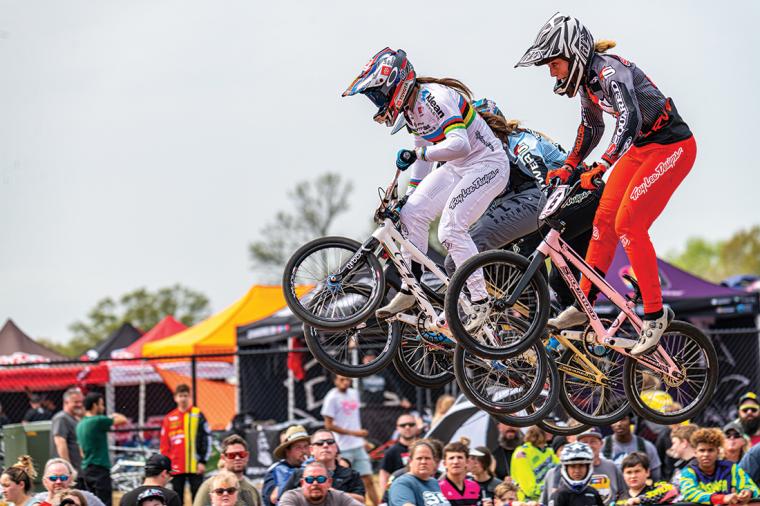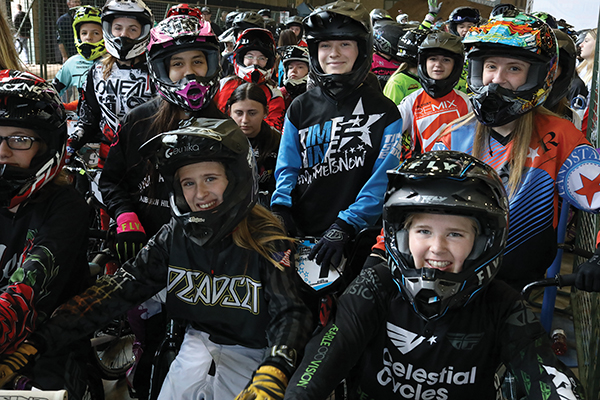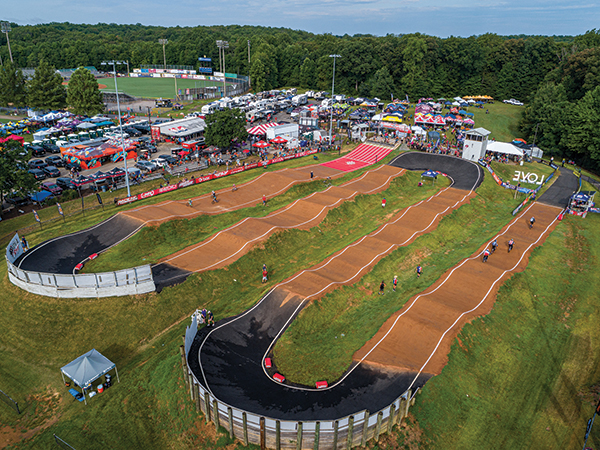

One of the sports that got up and running quickly in 2020 was BMX, and in the intervening three years, it has not slowed down at all. In fact, the last three-year period was the most exciting and challenging we’ve ever experienced. Recapping that, we can look at several categories of growth and accomplishment.
Membership Growth
Right now, USA BMX is enjoying its highest membership ever, with more than 77,000 individuals on our rosters. The pandemic brought a lot of people outside and encouraged them to find sports that were safe and fun. BMX checked those boxes; in addition, it’s an Olympic sport, which means that people, including kids, were able to see it on TV in 2021 and be inspired to take it up.
What’s unique is that this is a sport the whole family can enjoy; you don’t have parents driving up and dropping off their kids and then picking them up after a game has concluded. It is not uncommon for us to see a mom, dad, son and daughter (or any combination) have memberships in USA BMX and come to participate in events together.
Something else interesting is that most of our staff is made up of BMX athletes. As I noted a minute ago, this is something they did as a family and they like remaining connected to it.
Development of Venues

One initiative of USA BMX is helping to get new tracks built in cities nationwide. Interest from local clubs and communities is what generally spurs this development, although most BMX tracks are typically developed in partnership with a city or county entity and a DMO.
Our website, usabmx.com, includes a section devoted to this topic. In addition to providing answers to Frequently Asked Questions about facilities, construction and what USA BMX can do to help, there are links to potential operational resources, including information about professional services, facility design and architectural services, as well as links to vendors of various equipment.
We are able to inform destinations that a well-built BMX track can be not only an economic driver but a true community asset. We are consistently able to leverage the ROI of our sports tourism success to assist municipalities in the raising of the funds to develop new facilities. And once built, the facility is maintained through a partnership with the local organization, with day-to-day programing and business managed through a use agreement with that local organization. USA BMX will train local operators in maintenance and care of facilities and has a full-time staff in place to provide support as needed.
Most of the facilities being designed and built now are outdoors. In many cases, we can help cities work them into parks that are still in the master planning stages; however, we do find ways to incorporate tracks into existing parks as well, sometimes by repurposing areas that are not getting adequate use.
Overall, our work to grow the number of venues has been extremely successful. There are 326 sanctioned tracks in the U.S., with plenty of inquiries coming in all the time about building more. In fact, I would say we will probably see at least 10 more new facilities open before the end of this year alone.
There are plenty of success stories on our site but here are two. We just opened our new $26 million facility in Tulsa in February; in addition to serving as headquarters for our organization as well as the home of Hardesty National BMX Stadium, it also hosts the National BMX Hall of Fame and Museum. We expect it to draw more than 200,000 visitors per year – as well as being open for use by local riders.
Another piece of great news came in July of this year, with the announcement that the U.S. Department of Commerce’s Economic Development Administration (EDA) is awarding a $4.7 million grant to the Mylan Park Foundation in Morgantown, West Virginia to support construction of the Mylan Park Regional BMX Facility. This grant is funded by the American Rescue Plan and is expected to boost the sports tourism industry in a region that had been negatively impacted by the declining use of coal.
The track will bring new visitors to the city, its businesses and attractions. This EDA grant will be matched with $1.2 million in local funds and is expected to create 80 jobs, retain two jobs and generate $1.2 million in private investment, according to grantee estimates. In other words, it’s not just tournaments that local tracks can create – it’s opportunity, jobs and growth.
BMX Events in Demand
While much of our day-to-day work at USA BMX has been growing our big national events, we support a total of 326 local clubs and 11,000 events. (Those 11,000 events are sanctioned and insured by USA BMX, but they are run by local clubs. USA BMX runs the regional and national series events). And we’re seeing the demand for larger events continue to grow, in fact, one of our events has outgrown its longtime home and will be looking for a new venue in the future.
That kind of growth (both in terms of membership and in terms of tracks), as well as the demand for larger facilities, are great indicators of the health of our sport. As long as we continue to support the sport of BMX foundationally, it will continue to be in a great spot vertically.
STEM Initiative
Another point of pride has been our BMX STEM Program, which leverages BMX to foster greater involvement in science, technology, engineering and math. The USA BMX Foundation provides STEM educational resources for youth and teaching professionals as well as college scholarships for USA BMX members and track volunteers. Through this program, students use BMX bikes to perform various experiments that help them explore the world of STEM outside of textbooks, using various techniques:
Bike Builds: Each program receives kits to make five bikes. Bikes arrive disassembled, and students in teams of five are taught about how to build the bicycles. Along the way, they learn about the geometry of the frame and how to safely assemble all the components.
Bike Operation: Once all bikes have been put together safely, each team of five students takes turns doing real-life tests on the bike. For example, they will do a 40 yard dash on the bike, with one person riding and others acting as recorders. They’ll see how fast the bikes can go with the tires inflated to 40 psi as opposed to when they’re at 80 psi.
Track Modeling: Taking it one step further, students can experiment with track modeling and learn through STEAM (science, technology, engineering, the arts and math). After reviewing photos and ideas about BMX tracks around the country (and after field trips to nearby tracks), students develop sketches and ideas for tracks of their own design. They proceed through a variety of steps to actually modeling tracks that could potentially be used in competition. It’s a great way of bringing home the idea that classroom learning can be applied to the real world – and can be fun and interesting.
Currently, the BMX STEM Program is in 250 schools nationwide, and we’re just scratching the surface. We fully anticipate this will grow in the next few years. USA BMX has been involved with another program, Read to Ride, which has the goal of keeping kids engaged and reading, particularly during extended school breaks. That program has a great incentive – the top reader is awarded a new bike and a helmet, with prizes for other participants as well.
BMX just keeps on moving forward, thanks to our partnerships with other organizations. We are working with the American Bicycle Association (ABA) and partnering with them on their ABA Ethos program, which seeks to grow the sport of cycling in all its various disciplines by providing access to facilities and to programs.
The sport has had some incredible accomplishments since we touched base with SDM three years ago, and we are confident that it will continue to grow. We look forward to the future of our great sport. SDM

